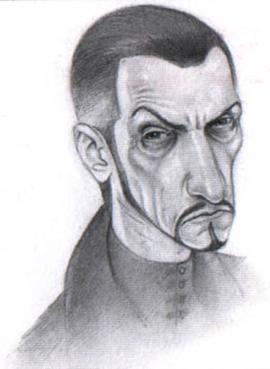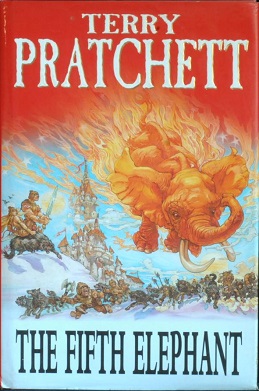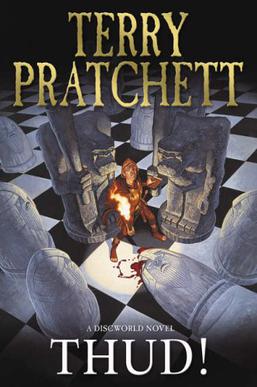
The Unseen University (UU) is a school of wizardry in Terry Pratchett's Discworld series of fantasy novels. Located in the fictional city of Ankh-Morpork, the UU is staffed by mostly indolent and inept old wizards. The university's name is a pun on the Invisible College, and many aspects of the university are references to Oxford and Cambridge University. The exploits of the head wizards of the Unseen University are one of the main plot threads in the long-running fantasy series, and have played a central role in 13 novels to date, as well as the four supplementary Science of Discworld novels and the short story, A Collegiate Casting-Out of Devilish Devices.

Jingo is a fantasy novel by British writer Terry Pratchett, the 21st book in his Discworld series. It was published in 1997.

Sourcery is a fantasy novel by British writer Terry Pratchett, the fifth book in his Discworld series, published in 1988.

Soul Music is a fantasy novel by British writer Terry Pratchett, the sixteenth book in the Discworld series, first published in 1994. Like many of Pratchett's novels it introduces an element of modern society into the magical and vaguely late medieval, early modern world of the Discworld, in this case Rock and Roll music and stardom, with near disastrous consequences. It also introduces Susan Sto Helit, daughter of Mort and Ysabell and granddaughter of Death.

The Colour of Magic is a 1983 fantasy comedy novel by Terry Pratchett, and is the first book of the Discworld series. The first printing of the British edition consisted of only 506 copies. Pratchett has described it as "an attempt to do for the classical fantasy universe what Blazing Saddles did for Westerns."

The Light Fantastic is a comic fantasy novel by Terry Pratchett, the second of the Discworld series. It was published on 2 June 1986, the first printing being of 1,034 copies. The title is taken from L'Allegro, a poem by John Milton, and refers to dancing lightly with extravagance, although in the novel it is explained as "the light that lies on the far side of darkness, the light fantastic. It was a rather disappointing purple colour."

Equal Rites is a comic fantasy novel by Terry Pratchett. Published in 1987, it is the third novel in the Discworld series and the first in which the main character is not Rincewind. The title is a play on words related to the phrase "Equal Rights".

Rincewind is a fictional character who appears in several of the Discworld novels by Terry Pratchett. He was a failed student at Unseen University for wizards in Ankh-Morpork, often described as "the magical equivalent to the number zero". He spent most of his time running away from people who wanted to kill him for various reasons. The reason that he was still alive and running was explained by noting that while he was born with a wizard's spirit, he had the body of a long-distance sprinter.

Lord Havelock Vetinari, Lord Patrician of the city-state of Ankh-Morpork, is a fictional character in Terry Pratchett's Discworld series. Vetinari has written an unpublished manuscript known as The Servant, the Discworld version of The Prince by the Italian statesman and diplomat Niccolò Machiavelli.

Men at Arms is a fantasy novel by British writer Terry Pratchett, the 15th book in the Discworld series, first published in 1993. It is the second novel about the Ankh-Morpork City Watch on the Discworld. Lance-constable Angua von Überwald, later in the series promoted to the rank of Sergeant, is introduced in this book. Lance-constable Detritus is introduced as a new member of the watch as well, though he had already appeared in other Discworld novels, most notably in Moving Pictures. Also notable is the only appearance of Lance-constable Cuddy.

The Fifth Elephant is a 1999 fantasy novel by British writer Terry Pratchett, the 24th book in the Discworld series. It introduces the clacks, a long-distance semaphore system.

Discworld Noir is a 1999 adventure game developed by Perfect Entertainment and published by GT Interactive. The game is set in Terry Pratchett's satirical Discworld universe, and follows its first and only private investigator as he is given a case leading him into the deadly and occult underbelly of the Discworld's largest city.
The Ankh-Morpork City Watch is a fictional police force appearing in Terry Prattchett's Discworld series. The Watch primarily functions out of the fictional city of Ankh-Morpork, but some stories do include members of the watch elsewhere in the world.

The Discworld is the fictional world where English writer Sir Terry Pratchett's Discworld fantasy novels take place. It consists of an interstellar planet-sized disc, which sits on the backs of four huge elephants, themselves standing on the back of a world turtle, named Great A'Tuin, as it slowly swims through space.

Thud! is a fantasy novel by British writer Terry Pratchett, the 34th book in the Discworld series, first released in the United States on 13 September 2005, then the United Kingdom on 1 October 2005. It was released in the U.S. three weeks before Pratchett's native UK in order to coincide with a signing tour. It was nominated for the Locus Award for Best Fantasy Novel in 2006.

Where's My Cow? is a picture book written by Terry Pratchett and illustrated by Melvyn Grant. It is based on a book that features in Pratchett's Discworld novel Thud!, in which Samuel Vimes reads it to his son.

The Discworld Diaries are a series of themed diaries based on the Discworld novels by Terry Pratchett. Each one is based on an Ankh-Morpork institution, and has an opening section containing information about that institution written by Pratchett and Stephen Briggs.

Terry Pratchett's The Colour of Magic is a fantasy-comedy two-part British television adaptation of the bestselling novels The Colour of Magic (1983) and The Light Fantastic (1986) by Terry Pratchett. The fantasy film was produced for Sky1 by The Mob, a small British studio, starring David Jason, Sean Astin, Tim Curry, and Christopher Lee as the voice of Death. Vadim Jean both adapted the screenplay from Pratchett's original novels, and served as director.

Discworld is a comic fantasy book series written by the English author Terry Pratchett, set on the Discworld, a flat planet balanced on the backs of four elephants which in turn stand on the back of a giant turtle. The series began in 1983 with The Colour of Magic and continued until the final novel The Shepherd's Crown, which was published in 2015, following Pratchett's death. The books frequently parody or take inspiration from classic works, usually fantasy or science fiction, as well as mythology, folklore and fairy tales, and often use them for satirical parallels with cultural, political and scientific issues.

















